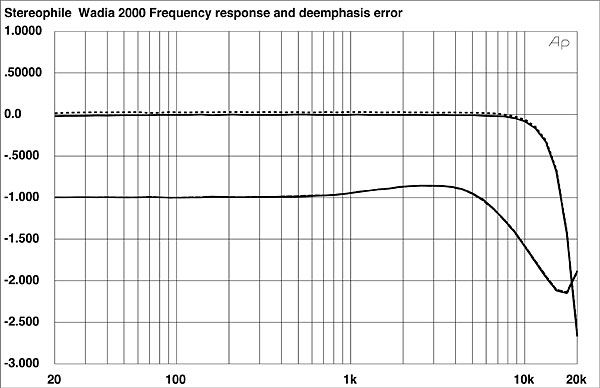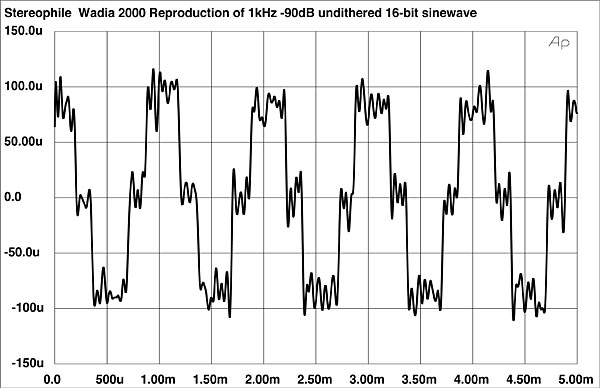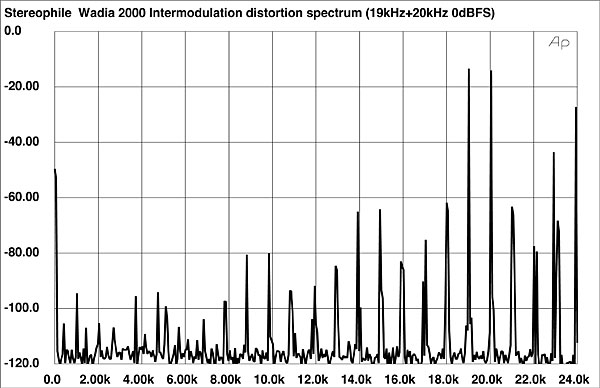| Columns Retired Columns & Blogs |
Wadia Digimaster 2000 Mk.2 digital processors December 1996
Follow-Up from December 1996 (Vol.19 No.12):
Wadia Digital has offered four upgrades of its 2000 Digital Decoding Computer since the model's 1989 debut. The first was a streamlined power supply that was much more aesthetically pleasing than the square metal box supplied with the first units. Multiple digital inputs on the 2000 also replaced the separate fiber-optical converter and its outboard power supply—necessary if you wanted to decode more than one digital source—and reduced the four-box 2000 to two.
The latest upgrade is much more extensive: the 2000's entire circuitry is removed and replaced with Wadia's latest technology. In fact, an updated 2000 is very similar in design topology to the Wadia 27 that I reviewed in the October 1996 issue (Vol.19 No.10, p.231). The 2000's four AT&T DSP chips have been replaced with two Motorola 56004s, which run an updated version of Wadia's Digimaster software, and also add digital-domain volume control. A remote control is included in the upgrade, and the front-panel overlay is replaced so that the amount of attenuation can be shown. The analog output level can be selected to match the needs of your power amplifier and keep the digital-domain attenuation to a minimum.
The upgraded 2000 features four Burr-Brown PCM1702 surface-mount DACs per channel in a differential configuration. The DACs are fed a 16x-oversampled signal from the custom digital filter, which multiplies the 16x-oversampling rate by four (see the Wadia 27 review for more technical details; both products work identically in this regard). The I/V converter is a Burr-Brown OPA-604, followed by a Burr-Brown BUF-634 output buffer. The clocking scheme is similar to that used in the 27: a Crystal CS8412 demodulates the incoming data, with the word clock generated by a Xilinx gate array and a VCXO (Voltage-Controlled Crystal Oscillator) next to the DAC. This new "Rock-Lock" circuit is an improvement over Wadia's original Rock-Lock anti-jitter circuit.
The 2000 lacks the 27's current-source preregulation in the power supply, has less shielding in the chassis, and isn't quite as refined as the ground-up engineering effort behind the 27. The upgraded 2000 and 27 share, however, some important circuits, including the same digital filter and decoding algorithm, DACs, output buffer (although the I/V converter is different), Rock-Lock clocking scheme, and the use of differential transmission lines on critical clock paths. The upgraded 2000's balanced and single-ended outputs can also be used simultaneously.
Upgrading a 2000 to current status costs $3690; with additional digital input, $4490. The single-input 2000 has glass-fiber input only; the dual-input option adds your choice of a second glass input, coax (on a BNC jack), or AES/EBU. The upgrade is performed at Wadia's factory, where the rebuilt unit is burned-in, tested, and given a new five-year warranty. Owners of Wadia's 64.4 Digital Decoding Computer can also upgrade to essentially the same unit as the 2000 for the same price of $3690. The 64.4 gets the same electronics as the 2000; the only difference is that the 2000 has an external power supply and the 64.4's supply is integral. The 64.4, which used to sell for $5000, has four digital inputs as standard.
All upgrades are handled through any authorized Wadia dealer. If the upgrade has been scheduled in advance, turnaround time is one week.
Listening to the 2000: The updated 2000 bore a strong family resemblance to the 27, both units producing a wonderful tangibility of instrumental and vocal images. The ability to create the impression of instruments and voices hanging in space against a black background seems to be a common Wadia quality. The updated 2000's soundstaging (like the 27's) was terrific—wide and deep, with razor-sharp image specificity and a sense of transparent space between images. The two processors' similar spatial presentations were different from the soundstaging of other makes of digital processors I've auditioned. The 2000, however, was a little more forward-sounding, without quite the degree of depth heard through the 27.
The 2000's upper bass was fuller and more generous than the 27's, and lacked the tautness and definition heard from the 27. Stanley Clarke's acoustic bass on the Airto Moreira and the Gods of Jazz disc Killer Bees (B&W Music BW041) was bigger, slower, and less articulate on the 2000 than through the 27. Although the 2000's bass had power and impact, it was just a little on the ripe side compared with the 27's tautness. Bass impact was, however, absolutely stunning. The 2000 had a power in the bottom octave that gave music a firmly anchored solidity. Kickdrum was startling in its impact. The large mounted toms on Trilok Gurtu's drumkit on John McLaughlin's Que Alegrìa (Verve 837 280-2) jumped out of the presentation with a big dynamic kick. The 2000's excellent dynamics and powerful bass emphasized the rhythmic power of music, something I greatly enjoyed about the 2000 (and the 27).
The main area in which the 2000 fell short of the 27 was in smoothness and liquidity. The 2000's treble was noticeably brighter, less clean, and harder than the 27's, lacking the 27's natural ease and unfatiguing quality. Similarly, the 2000's mids had a trace of edge not heard through the 27. Piano was less convincing through the 2000 than through the 27, sounding a little brittle and hard by comparison. I wouldn't call the 2000 edgy, but it didn't have the liquidity and ease of the 27.
I listened to and was greatly impressed by the 2000 for several weeks before receiving the 27. But switching back to the 2000 after hearing the 27 was a step down: still excellent, but not up to the very high standards set by the 27.
Driving the VT150 power amplifiers directly with the 2000 was a big advantage. Removing the preamplifier from the signal path took the 2000's performance up a notch, a phenomenon described in more detail in my review of the Wadia 27.
Measurements: The updated 2000's output level was 2.17V from either the balanced or unbalanced output. This output voltage was with the gain setting that worked best in my system. The balanced output impedance was 23 ohms, and the single-ended output impedance was less than one ohm. I was surprised at this disparity, considering that the balanced and unbalanced output jacks are driven from identical output buffers. DC levels measured less than 5mV from any output. The 2000 locked to 32kHz and 48kHz sampling frequencies.
The 2000's frequency response (fig.1) is identical to the response of every Wadia processor because they all (except the Wadia 12) use the same filter algorithm. The 2000's response was down nearly 3dB at 20kHz, and the de-emphasis error (bottom traces in fig.1) was rather large considering that the de-emphasis is performed by the digital filter. The 2000's squarewave reproduction is identical to that of the Wadia 27 (fig.10, October '96, p.238).

Fig.1 Wadia 2000, frequency response (top) and de-emphasis response (bottom) (right channel dashed, 0.5dB/vertical div.).
The 2000's channel separation (not shown), at better than 120dB across almost all the audioband, was among the highest I've measured. The 2000's channel separation was actually slightly better than that of the 27.
A 1/3-octave spectral analysis of the 27's output when decoding a 1kHz, –90dB dithered sinewave (fig.2) shows a low noise level, with just a trace of 120Hz power-supply noise in the left channel. The noise is almost nonexistent, however, at –128dB.

Fig.2 Wadia 2000, spectrum of dithered 1kHz tone at –90.31dBFS, with noise and spuriae (20-bit data, 1/3-octave analysis, right channel dashed).
The 2000's linearity was excellent, as can be seen in fig.3. This good low-level performance is also evident in fig.4, the 2000's reproduction of a 1kHz, –90dB undithered 16-bit sinewave. The quantization steps are uniform, the noise level is low, and the DACs have virtually no differential nonlinearity. Capturing the same waveform with 20-bit resolution gave the expected improvement in sinewave shape, confirming the 2000's excellent low-level resolution.

Fig.3 Wadia 2000, departure from linearity (right channel dashed, 2dB/vertical div.).

Fig.4 Wadia 2000, waveform of undithered 1kHz sinewave at –90.31dBFS (16-bit data).
Although the 2000 uses the same DACs as the Wadia 27, the 2000's noise-modulation performance (fig.5) was not as good. Two of the traces deviate from the others, indicating a slight shift in the noisefloor spectral balance as the input signal varies in amplitude. The overall noise level is, however, one of the lowest I've measured.

Fig.5 Wadia 2000, noise modulation, –60dBFS to –100dBFS (10dB/vertical div.).
Something was going on in the 2000 to produce the intermodulation distortion spectrum of fig.6. When driven by an equal mix of 19kHz and 20kHz at full scale, the 2000 generated a high number and level of IMD products. The 24kHz product, possibly the result of an interaction between the 44.1kHz sampling frequency and the 20kHz test signal, is nearly as high in level as the test tones. The 2000's propensity to generate IMD products may be responsible for my impression in the listening room of a harder, brighter sound than the Wadia 27. Although you'd never find a musical signal with a full-scale mix of 19kHz and 20kHz, the 2000 nonetheless produces more IMD products than most converters.

Fig.6 Wadia 2000, HF intermodulation spectrum, DC–24kHz, 19+20kHz at 0dBFS (linear frequency scale, 20dB/vertical div.).
Because the 2000 has only AES/EBU and ST-Type glass-fiber inputs, I measured its jitter driven by a glass link from the PS Audio Lambda transport. (The Lambda we have isn't fitted with an AES/EBU output.) Because the 2000's Digimaster filter is a 16x-oversampling filter, the word-clock frequency was 705.6kHz rather than the 352.8kHz (8x) clock we usually measure.
Fig.7 is the 2000's clock-jitter spectrum when driven by a full-scale 1kHz sinewave. We can see some periodic jitter components, but the spectrum is fairly clean overall. The RMS jitter level, measured over a 400Hz–20kHz bandwidth, was just 35 picoseconds. This RMS level is lower than that measured in the Wadia 27, but the 2000's spectrum isn't as clean. The 27 had virtually no periodic jitter components in its spectrum.

Fig.7 Wadia 2000, word-clock jitter spectrum, DC–20kHz, when processing 1kHz sinewave at 0dBFS; PS Audio Lambda transport, ST-optical connection (linear frequency scale, 10dB/vertical div., 0dB=1ns).
Fig.8 is the jitter spectrum when the 2000 was fed an input signal of all zeros. The spectrum shows the jitter as nearly completely random, and the RMS level as an astonishingly low 20ps. It's interesting that the 2000 has lower RMS jitter than the 27, but a less clean jitter spectrum.

Fig.8 Wadia 2000, word-clock jitter spectrum, DC–20kHz, when processing digital silence; PS Audio Lambda transport, ST-optical connection (linear frequency scale, 10dB/vertical div., 0dB=1ns).
The 2000's measurements were impressive overall, except for the unusual intermodulation distortion spectrum. The unit had low noise, low crosstalk, good linearity, and low jitter. The updated 2000 is not only much better than its predecessor musically, but technically as well.
Conclusion: It's been so long since I heard the original 2000 that I can't make a direct comparison with this most recent update. I can say, however, that the fully up-to-date 2000 is competitive with today's high-end converters in the five- to six-thousand-dollar price range. Considering the dramatic increase in sound quality from digital playback over the past seven years, that's saying a lot. It's great to see a seven-year-old digital product brought up to today's standards with a relatively moderately priced upgrade.
There's no question that owners of the original 2000 should buy this upgrade; you'll get today's sound quality for a reasonable upgrade price. Owners of intermediate incarnations of the 2000 are advised to compare their units against the most recent update to hear if the upgrade cost is justified. This upgrade is, however, a total replacement of the electronics.
However, if you're considering buying a used 2000 and having it updated, you may, after reading my review of the Wadia 27, want to consider spending the extra money for the newer unit—it sounds even better than the 2000.—Robert Harley
- Log in or register to post comments




































